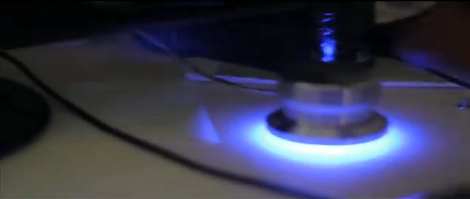
[Fred] likes to squeeze every cycle possible out of his graphics card. But sometimes pushing the clock speed too high causes corruption. He figured out a way to turn a knob to adjust the clock speed while your applications are still running.
The actuator seen above is a Griffin Powermate 3.0. It’s a USB peripheral which is meant to be used for anything you can imagine. [Fred] uses an AutoHotKey script that he wrote to capture the input from the spinner, process that information, then adjust GPU clock speed in the background. Since the clock on his ATi Radeon 5800 can be adjusted using the AMD GPU clock tool, it’s an easy choice for this application. Now better graphics are at the tips of his fingers. See for yourself in the video after the break.
Of course if you don’t want to shell out for the fancy hardware you could always build your own paddle controller.
[youtube=http://www.youtube.com/watch?v=Kfb-RznGoKU&w=470]















Does it go up to 11?
It’s all fun and games, until one of your idiot friends comes over and turns the knob to max.
I think that the actual graphic cards doesn’t do clock throttling if the GPU temperature rises above a established temperature. Maybe I’m wrong.
I mean. If your GPU it’s not almost 100% of use, doesn’t make much sense overclock it. There will be little difference.
If the GPU it’s 100% busy almost all time, and you overclock it -even a little bit- the temperature will rise non linearly.
I think is something like this:
+5% overclock -> +3% performance -> +8% temperature.
With not much overclocking, but running heavy applications that stress the GPU, the temperature will rise. And at certain point the graphic card will star doing increased throttling till the temperature reach again the low hysteresis point.
Performance will be degraded while this occurs.
Now cooling. You can change the stock heat-sinks, heat-pipes, fans, water, pumps and al the overclocking heavy weapons.
At what cost?
Less cost than the price difference between that card and other superior card that have at least the performance that you have gained overclocking it?
And with the overclock the hardware suffers.
> If your GPU it’s not almost 100% of use, doesn’t make much sense overclock it.
The overclocking on modern Radeons is setting the upper limit the card can operate at. Based on activity, the card will increase the clocks dynamically. At 90%, they generally are in the highest range; the one set by overclocking in CCC.
> I think is something like this:
+5% overclock -> +3% performance -> +8% temperature.
Which clock? The Engine clock or the Memory clock? If the game is fill rate bound, you want to increase your memory clocks. If it’s computation bound, then the engine clocks. The operating temperature for the card is also determined by the air flow over the card and ambient temperature of your case. The thermal sensors “should” prevent a burning situation but obviously not something covered by your warranty.
> With not much overclocking, but running heavy applications that stress the GPU, the temperature will rise. And at certain point the graphic card will star doing increased throttling till the temperature reach again the low hysteresis point.
First the fan controllers will kick up. Under the sustained load, if it can’t cool, then the clocks will drop to stay within range. If it happens too fast, the card will probably lock up and recover, generally destroying the software context and the application in the process… hopefully.
>Now cooling. You can change the stock heat-sinks, heat-pipes, fans, water, pumps and al the overclocking heavy weapons.
At what cost?
Less cost than the price difference between that card and other superior card that have at least the performance that you have gained overclocking it?
And with the overclock the hardware suffers.
Agreed. Much of this can be said of CPU overclocking as well. The difference is that manufacturers produce the products to bin in a certain range knowing full well they may exceed the bin they are placed in – the low bar. There’s also the obvious ego shot of overclocking or the “because I can” attitude – much like most people hacking :)
Sorry I mean “do throttling” instead “doesn’t do”
You mean “Does” :P
So this controller, you sell it?
Peddle = verb “to sell”
Pedal = noun “thing you mash with your foot”
I think he meant:
Paddle: noun “a rotary controller such as the one used in old Pong machines”
“like”, “+1” etc
That is quite extremely awesome, gonna have to do this myself with maybe a TI Launchpad + touch addon because I have those lying around. Only addition he should really make is add a second knob for fan control or just up the fan speed at the same time the clock speed goes up. I’ve got some gainward version of the Nvidia GTX 260 and the fans are retarded! 40% duty cycle then + 1% per degree, means the card hits about 80°C unless I take control of the fan and overclocking only worsens the issue. I’d love to have hardware control of the fans in this style :D